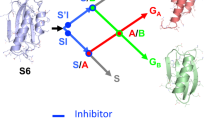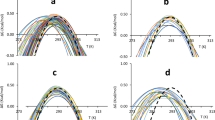Abstract
We present a structural analysis of the folding transition states of three SH3 domains. Our results reveal that the secondary structure is not yet fully formed at this stage of folding and that the solvent is only partially excluded from the interior of the protein. Comparison of the members of the transition state ensemble with a database of native folds shows that, despite substantial local variability, the transition state structures can all be classified as having the topology characteristic of an SH3 domain. Our results suggest a mechanism for folding in which the formation of a network of interactions among a subset of hydrophobic residues ensures that the native topology is generated. Such a mechanism enables high fidelity in folding while minimizing the need to establish a large number of specific interactions in the conformational search.
This is a preview of subscription content, access via your institution
Access options
Subscribe to this journal
Receive 12 print issues and online access
$189.00 per year
only $15.75 per issue
Buy this article
- Purchase on Springer Link
- Instant access to full article PDF
Prices may be subject to local taxes which are calculated during checkout







Similar content being viewed by others
References
Dobson, C.M. & Karplus, M. The fundamentals of protein folding: Bringing together theory and experiment. Curr. Opin. Struct. Biol. 9, 92–101 (1999).
Daggett, V. & Fersht, A.R. Is there a unifying mechanism for protein folding? Trends Biochem. Sci. 28, 18–25 (2003).
Vendruscolo, M. & Paci, E. Protein folding: Bringing theory and experiment closer together. Curr. Opin. Struct. Biol. 13, 82–87 (2003).
Jackson, S.E. How do small single-domain proteins fold? Fold. Des. 3, R81–R91 (1998).
Grantcharova, V.P., Alm, E.J., Baker, D. & Horwich, A.L. Mechanisms of protein folding. Curr. Opin. Struct. Biol. 11, 70–82 (2001).
Matouschek, A., Kellis, J.T., Serrano, L. & Fersht, A.R. Mapping the transition state and pathway of protein folding by protein engineering. Nature 340, 122–126 (1989).
Vendruscolo, M., Paci, E., Dobson, C.M. & Karplus, M. Three key residues form a critical contact network in a protein folding transition state. Nature 409, 641–645 (2001).
Paci, E., Vendruscolo, M., Dobson, C.M. & Karplus, M. Determination of a transition state at atomic resolution from protein engineering data. J. Mol. Biol. 324, 151–163 (2002).
Martinez, J.C., Pisabarro, M.T. & Serrano, L. Obligatory steps in protein folding and the conformational diversity of the transition state. Nat. Struct. Biol. 5, 721–729 (1998).
Riddle, D.S. et al. Experiment and theory highlight role of native state topology in SH3 folding. Nat. Struct. Biol. 6, 1016–1024 (1999).
Martinez, J.C. & Serrano, L. The folding transition state between SH3 domains is conformationally restricted and evolutionarily conserved. Nat. Struct. Biol. 6, 1010–1016 (1999).
Northey, J.G., Nardo, A.D. & Davidson, A.R. Hydrophobic core packing in the SH3 domain folding transition state. Nat. Struct. Biol. 9, 126–130 (2002).
Northey, J.G., Maxwell, K.L. & Davidson, A.R. Protein folding kinetics beyond the Φ value: Using multiple amino acid substitutions to investigate the structure of the SH3 domain folding transition state. J. Mol. Biol. 320, 389–402 (2002).
Larson, S.M. & Davidson, A.R. The identification of conserved interactions within the SH3 domain by alignment of sequences and structures. Protein Sci. 9, 2170–2180 (2000).
Ventura, S. et al. Conformational strain in the hydrophobic core and its implications for protein folding and design. Nat. Struct. Biol. 9, 485–493 (2002).
Fersht, A.R., Itzhaki, L.S., elMasry, N.F., Matthews, J.M. & Otzen, D.E. Single versus parallel pathways of protein folding and fractional structure in the transition state. Proc. Natl. Acad. Sci. USA 91, 10426–10429 (1994).
Davis, R., Dobson, C.M. & Vendruscolo, M. Determination of the structures of distinct transition state ensembles for a β-sheet peptide with parallel folding pathways. J. Chem. Phys. 117, 9510–9517 (2002).
Lazaridis, T. & Karplus, M. Effective energy function for protein dynamics and thermodynamics. Proteins 35, 133–152 (1999).
Lindorff-Larsen, K., Paci, E., Serrano, L., Dobson, C.M. & Vendruscolo, M. Calculation of mutational free energy changes in transition states for protein folding. Biophys. J. 85, 1207–1214 (2003).
Schwieters, C.D. & Clore, G.M. Reweighted atomic densities to represent ensembles of NMR structures. J. Biomol. NMR 23, 221–225 (2002).
Gsponer, J. & Caflisch, A. Molecular dynamics simulations of protein folding from the transition state. Proc. Natl. Acad. Sci. USA 99, 6719–6724 (2002).
Murzin, A.G., Brenner, S.E., Hubbard, T. & Chothia, C. SCOP: A structural classification of proteins database for the investigation of sequences and structures. J. Mol. Biol. 247, 536–540 (1995).
Holm, L. & Sander, C. Mapping the protein universe. Science 273, 595–602 (1996).
Brenner, S.E., Koehl, P. & Levitt, M. The ASTRAL compendium for protein structure and sequence analysis. Nucleic Acids Res. 28, 254–256 (2000).
Dietmann, S., Fernandez-Fuentes, N. & Holm, L. Automatic detection of remote homology. Curr. Opin. Struct. Biol. 12, 362–367 (2002).
Debe, D.A., Carlson, M.J. & Goddard III, W.A. The topomer-sampling model of protein folding. Proc. Natl. Acad. Sci. USA 96, 2596–2601 (1999).
Makarov, D.E. & Plaxco, K.W. The topomer search model: A simple, quantitative theory of two-state protein folding kinetics. Protein Sci. 12, 17–26 (2003).
Khorasanizadeh, S., Peters, I.D. & Roder, H. Evidence for a three-state model of protein folding from kinetic analysis of ubiquitin variants with altered core residues. Nat. Struct. Biol. 3, 193–205 (1996).
Poso, D., Sessions, R.B., Lorch, M. & Clarke, A.R. Progressive stabilization of intermediate and transition states in protein folding reactions by introducing surface hydrophobic residues. J. Biol. Chem. 276, 35723–35726 (2000).
Viguera, A.R., Vega, C. & Serrano, L. Unspecific hydrophobic stabilization of folding transition states. Proc. Natl. Acad. Sci. USA 99, 5349–5354 (2002).
Cheung, M.S., García, A.E. & Onuchic, J.N. Protein folding mediated by solvation: Water expulsion and formation of the hydrophobic core occur after the structural collapse. Proc. Natl. Acad. Sci. USA 99, 685–690 (2002).
Shea, J.-E., Onuchic, J.N. & Brooks 3rd., C.L. Probing the folding free energy landscape of the src-SH3 protein domain. Proc. Natl. Acad. Sci. USA 99, 16064–16068 (2002).
Guo, Z., Brooks 3rd., C.L. & Boczko, E.M. Posttransition state desolvation of the hydrophobic core of the src-SH3 protein domain. Biophys. J. 85, 61–69 (2003).
Lee, B. & Richards, F.M. The interpretation of protein structures: estimation of total static accessibility. J. Mol. Biol. 55, 379–400 (1971).
Müller, N. Search for a realistic view of hydrophobic effects. Acc. Chem. Res. 23, 23–28 (1990).
Baldwin, R.L. & Rose, G.D. Is protein folding hierarchic? II. Folding intermediates and transition states. Trends Biochem. Sci. 24, 77–83 (1999).
Andersen, C.A.F., Palmer, A.G., Brunak, S. & Rost, B. Continuum secondary structure captures protein flexibility. Structure 10, 175–184 (2002).
Viguera, A.R., Jimenez, M.A., Rico, M. & Serrano, L. Conformational analysis of peptides corresponding to β-hairpins and a β-sheet that represent the entire sequence of the α-spectrin SH3 domain. J. Mol. Biol. 255, 507–521 (1996).
Gnanakaran, S. & Garcia, A.E. Folding of a highly conserved diverging turn motif from the SH3 domain. Biophys. J. 84, 1548–1562 (2003).
Yi, Q., Bystroff, C., Rajagopal, P., Klevit, R.E. & Baker, D. Prediction and structural characterization of an independently folding substructure in the src SH3 domain. J. Mol. Biol. 283, 293–300 (1998).
Watts, D.J. & Strogatz, S.H. Collective dynamics of 'small world' networks. Nature 393, 440–442 (1998).
Vendruscolo, M., Dokholyan, N.V., Paci, E. & Karplus, M. Small-world view of the amino acids that play a key role in protein folding. Phys. Rev. E 65, 061910 (2002).
Grantcharova, V.P., Riddle, D.S. & Baker, D. Long-range order in the src SH3 folding transition state. Proc. Natl. Acad. Sci. USA 97, 7084–7089 (2000).
Ikeda, K., Galzitskaya, O.V., Nakamura, H. & Higo, J. β-Hairpins, α-helices, and the intermediates among the secondary structures in the energy landscape of a peptide from a distal β-hairpin of SH3 domain. J. Comp. Chem. 24, 310–318 (2003).
Larson, S.M., Di Nardo, A.A. & Davidson, A.R. Analysis of covariation in an SH3 domain sequence alignment: Applications in tertiary contact prediction and the design of compensating hydrophobic core substitutions. J. Mol. Biol. 303, 433–446 (2000).
Cobos, E.S. et al. A thermodynamic and kinetic analysis of the folding pathway of an SH3 domain entropically stabilised by a redesigned hydrophobic core. J. Mol. Biol. 328, 221–122 (2003).
Yi, Q., Rajagopal, P., Klevit, R.E. & Baker, D. Structural and kinetic characterization of the simplified SH3 domain FP1. Protein Sci. 12, 776–783 (2003).
Brooks, B.R. et al. CHARMM: A program for macromolecular energy, minimization and dynamics calculations. J. Comp. Chem. 4, 187–217 (1983).
Neria, E., Fischer, S. & Karplus, M. Simulation of activation free energies in molecular dynamics system. J. Chem. Phys. 105, 1902–1921 (1996).
Holm, L. & Park, J. DaliLite workbench for protein structure comparison. Bioinformatics 16, 566–567 (2000).
Acknowledgements
We are very grateful to M. Karplus for continuing interest and support. We thank J. Clarke, X. Salvatella, L. Serrano and J. Winther for valuable discussions, and A. Davidson and L. Serrano for sharing experimental data before publication. We are grateful to L. Serrano for providing FOLD-X, B. Rost for DSSPcont and L. Holm for DaliLite. K.L.L. is supported by the Danish Research Agency. M.V. is a Royal Society University Research Fellow. The research of C.M.D. is supported in part by a Programme Grant from the Wellcome Trust and by the Leverhulme Trust.
Author information
Authors and Affiliations
Corresponding author
Ethics declarations
Competing interests
The authors declare no competing financial interests.
Supplementary information
Rights and permissions
About this article
Cite this article
Lindorff-Larsen, K., Vendruscolo, M., Paci, E. et al. Transition states for protein folding have native topologies despite high structural variability. Nat Struct Mol Biol 11, 443–449 (2004). https://doi.org/10.1038/nsmb765
Received:
Accepted:
Published:
Issue Date:
DOI: https://doi.org/10.1038/nsmb765
This article is cited by
-
The loop hypothesis: contribution of early formed specific non-local interactions to the determination of protein folding pathways
Biophysical Reviews (2013)
-
Assessing and refining molecular dynamics simulations of proteins with nuclear magnetic resonance data
Biophysical Reviews (2012)
-
The redundancy of NMR restraints can be used to accelerate the unfolding behavior of an SH3 domain during molecular dynamics simulations
BMC Structural Biology (2011)
-
Simultaneous determination of protein structure and dynamics
Nature (2005)



